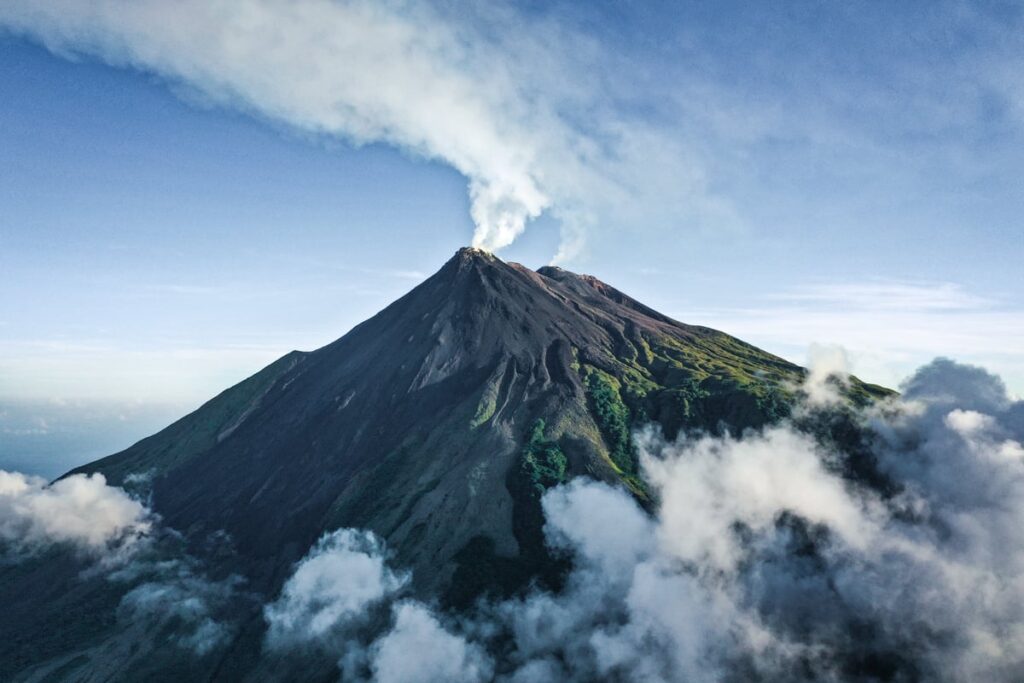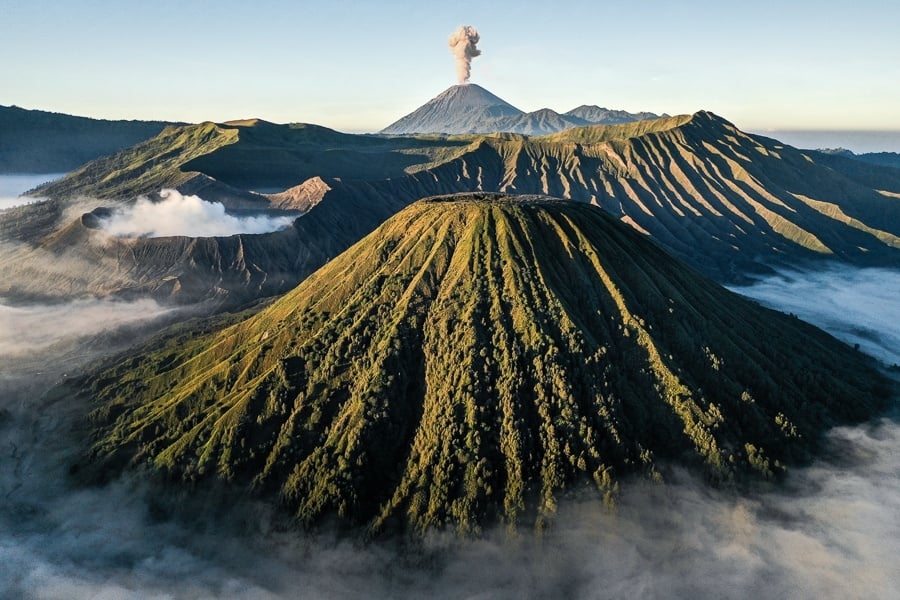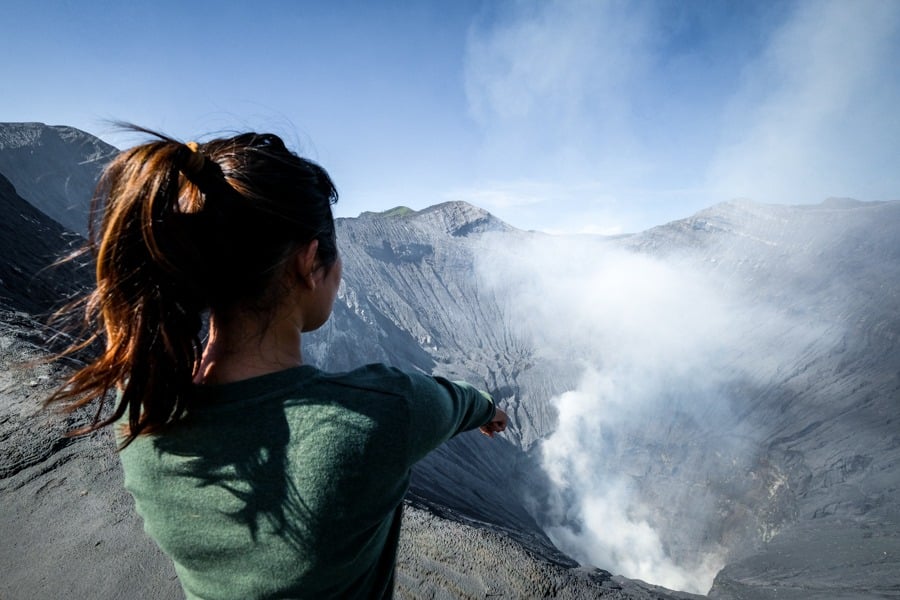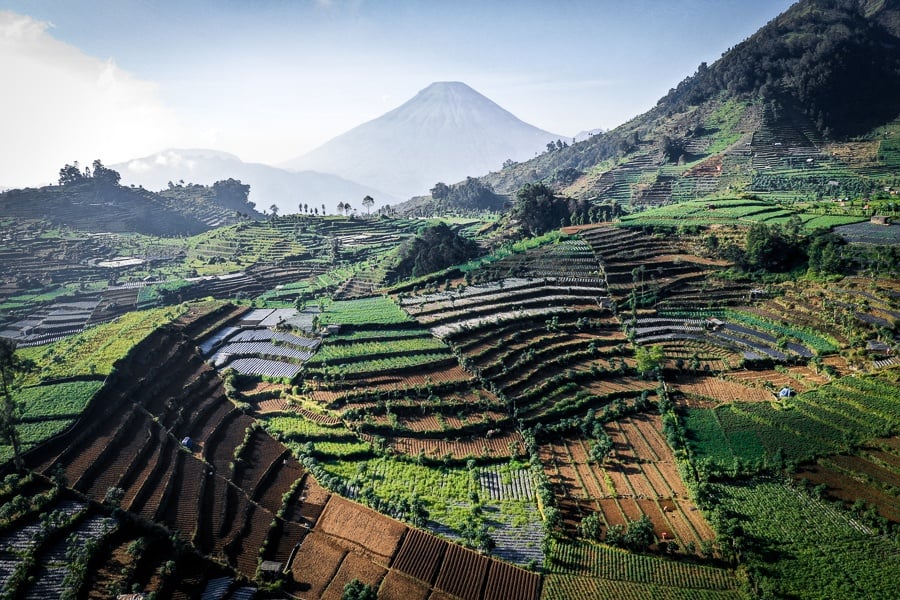25 Best Hikes In Indonesia: Volcanoes, Jungles, & Waterfalls

The best hikes in Indonesia feature smoking volcano craters, giant waterfalls, magnificent jungles, and exotic wildlife that can’t be found anywhere else on Earth.
This island nation is home to 400 volcanoes, more than any other country in the world, and most of these are open to tourists for hiking. Even though the most popular Indonesia volcano hike is probably Mount Batur in Bali, there are actually even better volcanoes to climb in places like Java, Maluku, Sulawesi, and Sumatra.
Indonesia has almost 20 percent of the world’s animal species, so there’s also a lot of endemic wildlife you can see here if you go trekking in the jungle, including the gentle orangutans and the beastly Komodo dragons!
I’ll never forget my first trip to Sulawesi, when I realized how many amazing hiking trails are waiting to be discovered in Indonesia if you just go off the beaten path and start exploring new islands.
Now that Indonesia is my second home (and my wife’s actual home!), I plan to keep this guide updated as we find more of the best hikes in Indonesia. If one of your favorite Indonesia hikes is missing from this list, you’re also welcome to recommend it in the comments at the bottom of this travel blog post!
Best Hikes In Indonesia
1. Mount Bromo (East Java)
Mount Bromo is an epic Indonesia volcano hike in East Java, with stunning views of an entire cluster of volcanoes, as well as an active crater you can climb for close up views.
The easiest way to visit Bromo is to fly to Malang or Surabaya, and then book a day tour to Bromo from there.
A full day tour is enough time to see all the highlights of the park — the sunrise, jeep ride in the sea of sand, and hike to the volcano crater — and then you can even add the Madakaripura waterfall as a bonus to the itinerary.

No hiking is required to see the classic main viewpoint at Mount Bromo, but if you want to get up close and peek inside of the smoking crater then you need to do a bit of hiking.
The full hike to the top of the Mount Bromo crater (starting from the sea of sand) takes about 1 hour, although you can speed it up if you ride a horse partway.
The last part of the hike has to be done on foot, and it’s a short but steep climb up a concrete stairway to the top of the crater.
Once at the top of the crater, you get to look directly into a smoking volcano, complete with the nasty sulfur smell!
Difficulty: Easy / Moderate

2. Kawah Ijen (East Java)
The volcanic crater lake at Kawah Ijen is the world’s biggest acid lake, and it’s also famous for a crazy ‘blue fire’ phenomenon where you can see hot blue flame burning like lava in the dark.
Since Mount Ijen is located at the far east end of Java, it’s pretty easy to visit from Bali and other parts of Indonesia. Most people either visit Mount Ijen on an overnight tour from Bali, or do it as a road trip combined with Mount Bromo and other epic sights in East Java.
The hike to the Kawah Ijen volcano is all dirt and fairly steep, but the path is well defined and safe. You will definitely work up a sweat because of the incline, so for people who don’t do much hiking I’d rate it as moderate.

In total, the hike to see the lake takes about 1.5 hours depending on your pace. If you walk quickly I’m sure you could do it in 1 hour, and even slow hikers won’t take more than 2 hours to reach the lake.
A tour guide is not required for the hike, although it can be helpful to have one if you want to see the Kawah Ijen blue fire, which requires a midnight start, a gas mask, and some extra hiking time to go down inside of the crater.
For those of you who plan to skip the blue fire (like we usually do), you don’t need to start at midnight, although I would still recommend you start early and try to reach the Kawah Ijen crater lake for sunrise if you want the best views and pictures.
3. Tumpak Sewu Waterfall (East Java)
The Tumpak Sewu waterfall in East Java is becoming famous as one of the most amazing waterfalls in Indonesia, or anywhere in Southeast Asia for that matter.
This thing is called a waterfall, but it’s more like a thousand waterfalls put together, which is why the name loosely translated from the local Java language means ‘many waterfalls.’
These falls thunder down into a horseshoe shaped jungle ravine that looks like something right out of Jurassic Park. The end result is an unmissable natural wonder!

After you get done admiring the falls from above, there’s a hiking path to go down and see the waterfall up close.
Head down the path for about 20 minutes to reach the bottom of the ravine. The path is mostly bamboo steps with bamboo railings, and it’s a little sketchy in spots, but nothing too terrible. Just proceed carefully.
Once you reach the bottom of the ravine, you’re only a 5-10 minute walk away from the main event at Tumpak Sewu waterfall. The towering walls on either side of the ravine let you know how tiny you are, and how epic things are about to get!
Difficulty: Easy / Moderate
4. Kabut Pelangi Waterfall (East Java)
The hills and mountains in Java are full of amazing waterfalls, but one of the best is Kabut Pelangi waterfall in East Java.
This one is not quite as well known as Tumpak Sewu, but it’s at least as spectacular in my opinion, and many people visit it in conjunction with Tumpak Sewu on a day trip from Malang.
The hike to Kabut Pelangi takes about 45 minutes one way, and going back takes a bit longer because it’s a steep hillside. It’s not a very difficult track to the main waterfall, but the path can be hard to see sometimes, especially if you go during or soon after the rainy season.
We went in May and things were a little overgrown in places, and there were several stream crossings that required getting your feet wet. The path should improve as this spot becomes more popular.
In any case, Kabut Pelangi is well worth the trek. If you like waterfalls, then this is definitely one of the best hikes in Indonesia!

5. Sikunir Hill (Central Java)
The Dieng Plateau is a natural wonder tucked in the highlands of central Java, Indonesia, not too far from the city of Yogyakarta.
This former caldera complex has everything from active volcanoes to ancient Hindu temples, smoking sulfuric springs, multicolored lakes, fresh mountain air, sunrise views, and endless terraces covering the hills in every direction.
Dieng means ‘Abode of the Gods,’ and that name seems about right for the incredible scale and mystery of this place!

One of the main attractions of Dieng Plateau is watching the sunrise over Mount Sundoro, one of Java’s active volcanoes.
The popular spot to do this is on Sikunir Hill, at the eastern edge of the plateau. Your driver can help you find the trailhead, and the path itself is pretty easy to follow.
From the car park, it’s a steep but short hike to the top of the hill, and only takes about 30-45 minutes. Even on a foggy day, the sunrise was beautiful!
Search Post
Latest Post
Featured
© 2025 All Right By Reserved Blue Chip Booking